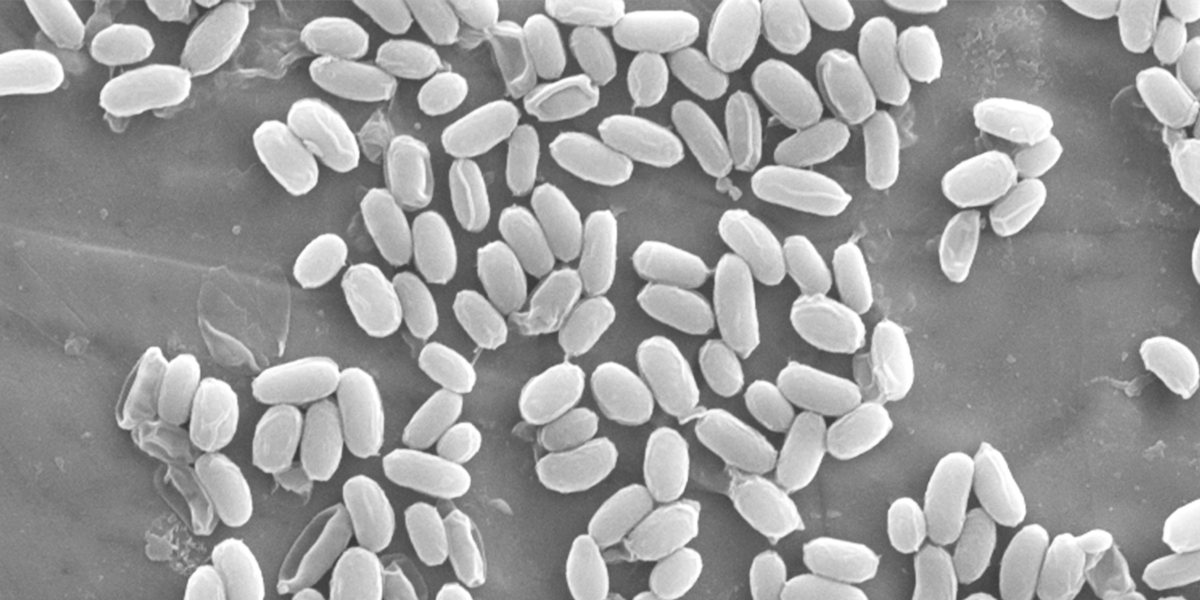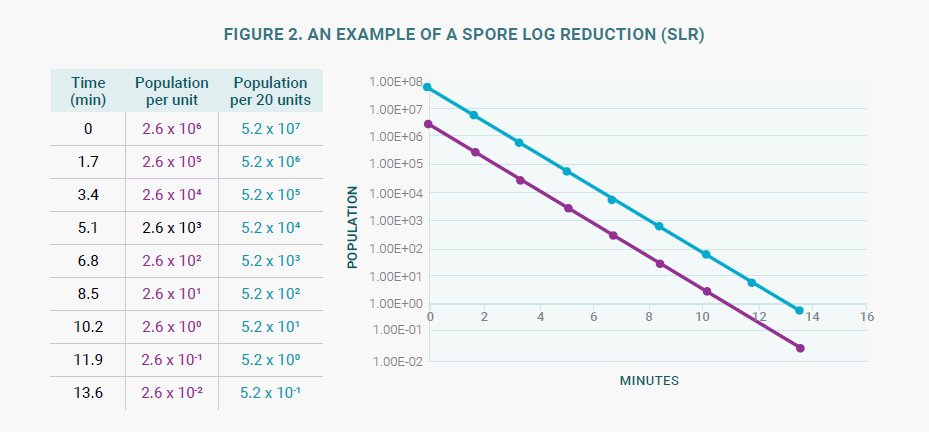
SN010-V1
Calculation of the Biological Indicator D-value and Kill Time not Specified on the Certificate of Analysis

By Kurt McCauley
Data presented on the Certificate of Analysis (COA) for biological indicators (BI) used to monitor steam sterilization processes typically include the spore population, D-value(s) determined at one or more temperatures and the z-value.
Often, the end users of the BIs are operating their sterilizers at a temperature for which the D-value is not reported on the C of A. A common question BI users ask is “Can I calculate the D-value and kill time of the BI when my sterilization temperature is not one of those listed on the Certificate of Analysis?”
SURVIVAL-KILL TIME CALCULATIONS¹
Survival time/dose = not less than the D-value X (log10 labeled viable test organism count per carrier - 2)
Kill time/dose = not more than the D--value X (log10 labeled viable test organism count per carrier + 2)
To calculate the theoretical kill time of the BI at a specified temperature, two data points are required; the initial population of the BI, and the D-value at the specified temperature. This Spore News will address the methods for calculating the D-value and the theoretical kill time in these situations. For the purpose of this discussion, we will not be using the survival/kill time calculation formulas as presented in ISO and USP1. These formulas add a safety factor into the calculations resulting in values that generally bracket the empirically derived data. In other words, the calculated kill time value will be higher than the empirically determined kill time.
The calculated kill time value targets a 10-spore log reduction (using BIs with a 106 spore count) which is significantly greater than that needed to inactivate a single BI.
Let’s begin by calculating the theoretical kill time for a temperature that is listed on the COA. Data extracted from a COA for a BI lot (Figure 1) shall be used in the following examples.
| Temperature | D-Value | Survival | Kill |
| 121ºC | 1.7 | 7.51(²) | 17.71(²) |
| 132ºC | 0.3 | 1.0(³) | 3.0(³) |
| 134ºC | 0.3 | 1.0(³) | 2.5(³) |
| 135ºC | 0.2 | 0.5(³) | 2.0(³) |
| z-value 15.2ºC |
(¹) D-value calculated using the Limited Holcomb-Spearman-Karber method.
(²) Survival/Kill values are calculated according to ISO 11138.
(³) Empirically derived data.
EXAMPLE 1
Calculation of the BI Theoretical Kill Time at a Sterilization Temperature of 121ºC
The theoretical kill time is a product of the log of the population (N0) plus one (1) and the D-value.
Theoretical kill time = (Log10 N0 + 1) x D-value
The first step of this equation is to take the log of the initial population. It is often assumed that this will be the spore log reduction (SLR) required to reduce the spore population to zero surviving spores. This in fact is not true. This SLR will reduce the spore population to an average of 100 or one (100 = 1) surviving spore per BI (see Figure 2). One is added to the SLR in the calculation to reduce the number of spores to less than one per unit resulting in a growth negative BI.
From the COA for lot S-308 (Figure 1), the Heat Shocked population (N0) is 2.6 x 106 per unit and the D121-value is 1.7 minutes. Substituting these values into the equation we have:
Theoretical kill time = (Log10 2.6 x 106 + 1) x 1.7 minutes = 12.6 minutes
A single BI should be killed in approximately 12.6minutes. During data collection on BIs from lot S-308, the 12-minute exposure at 121ºC resulted in 8 units killed out of 20 exposed. Tracking the total spores of this exposure we have 2.6 x 106 spores per unit multiplied by 20 replicate units resulting in 5.2 x 107 spores. The theoretical kill time would then be (Log10 5.2 x 107 + 1) x 1.7 minutes = 14.8 minutes. The empirical data from the 14-minute exposures resulted in 20 units killed out
of 20 exposed. So, we see that the empirical data closely matches the theoretical calculations.

EXAMPLE 2
Calculation of the BI D-value and Theoretical Kill Time at a Sterilization Temperature of 131ºC
To calculate the theoretical kill time of a BI at a temperature not listed on the COA, the z-value must be considered. According to ISO 11138¹, the z-value is defined as “…the change in exposure temperature which corresponds to a 10-fold change in D-value.” In a practical sense, it is a measure of how susceptible a spore population is to changes in temperature. For example, if the z-value is 10ºC, then increasing the sterilization temperature by 10ºC degrees will result in a one log reduction of the D-value. If the z-value of lot S-308 were 10ºC rather than 15.2ºC, the D131-value would simply be a one log difference from the D121-value of 1.7 minutes or 0.17 minutes. Rarely does the situation occur where the mathematical calculations are this simple.
To determine the kill time for lot S-308, the first step will be to calculate the D131-value using the correct z-value. When the z-value and the actual sterilization temperature are not convenient numbers to work with mathematically, the following formula (derived from the z-value calculation formula presented in ISO 11138-3:1995(E) Annex B is necessary:
D1 = D2× 10(T2 - T1)/Z
Where:
- D1 is the D-value at temperature T1 (e.g. the D131-value)
- D2 is the known D-value at temperature T2 (e.g. D121-value = 1.7 minutes)
- Z is the Z-value (e.g. 15.2ºC)
Inserting these values into the formula we have:
D131 = 1.7 × 10(121 - 131)/15.2
D131 = 0.4 minutes
Theoretical kill time for the BI at 131ºC = (Log10 2.6 x 106 + 1) x 0.4 minutes = 3.0 minutes.
EXAMPLE 3 Calculation of the BI D-value and Theoretical Kill Time at a Sterilization Temperature of 116.5ºC
EXAMPLE 3
Calculation of the BI D-value and Theoretical Kill Time at a Sterilization Temperature of 116.5ºC
To determine the kill time, the first step will be to calculate the D116.5-value using the formula:
D1 = D2 × 10(T2 - T1)/Z
Where:
- D1 is the D-value at temperature T1 (e.g. the D116.5-value)
- D2 is the known D-value at temperature T2 (e.g. D121-value = 1.7 minutes)
- Z is the Z-value (e.g. 15.2ºC)
Inserting these values into the formula we have:
D116.5 = 1.7 × 10(121 - 116.5)/15.2
D116.5 = 3.4 minutes
Theoretical kill time for the BI at 116.5ºC = (Log10 2.6 x 106 + 1) x 3.4 minutes = 25.2 minutes.
EXAMPLE 4
Calculation of the BI D-value and Theoretical Kill Time at a Sterilization Temperature of 124ºC
To determine the kill time, the first step will be to calculate the D124-value using the formula:
D1 = D2 × 10(T2 - T1)/Z
Where:
- D1 is the D-value at temperature T1 (e.g. the D124-value)
- D2 is the known D-value at temperature T2 (e.g. D121-value = 1.7 minutes)
- Z is the Z-value (e.g. 15.2ºC)
Inserting these values into the formula we have:
D124 = 1.7 × 10(121 - 124)/15.2
D124 = 1.1 minutes
Theoretical kill time for the BI at 124ºC = (Log10 2.6 x 106 +1) x 1.1 minutes = 8.2 minutes.
A single BI should be killed in approximately 8.2 minutes. During data collection on BIs from lot S-308, the 8 minute exposure at 124ºC resulted in 17 units killed out of 20 exposed.
The D124-value was one of the D-values experimentally determined on lot S-308 and used in the Z-value calculation. The D124-value was determined to be 1.0 minute and the 9 minute exposure resulted in total kill of all 20 BIs.
The calculations very closely match the experimentally determined data.
Discussion
The z-value curves for Geobacillus stearothermophilus spores tend to be concave downward over a wide temperature range (i.e. the z-values tend to decrease as the temperature increases). The fact that resistometers (test vessels) perform most accurately at temperatures below 130ºC certainly contributes to this situation. Mesa calculates the z-value using D- values obtained from three temperatures in the 120ºC-130ºC range.
Based on the ISO requirements and Mesa current operating procedure for z-value determinations, this formula will result in a good estimation of D-values in the 110ºC- 130ºC temperature range using the z-value printed on the C of A . This is supported by comparing the empirically determined results with the calculated results as in examples 1 and 4.
References
1. ISO 11138–1: 2017 Sterilization of health care products—Biological indicators—Part 1: General
requirements
2. ISO 18472: 2022 Sterilization of health care products—Biological and chemical indicators—Test equipment.